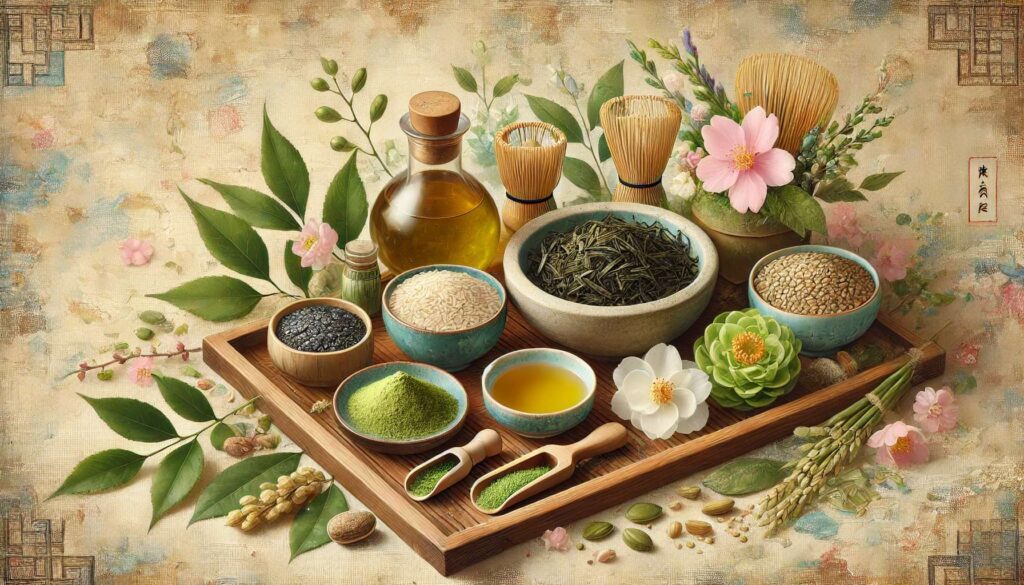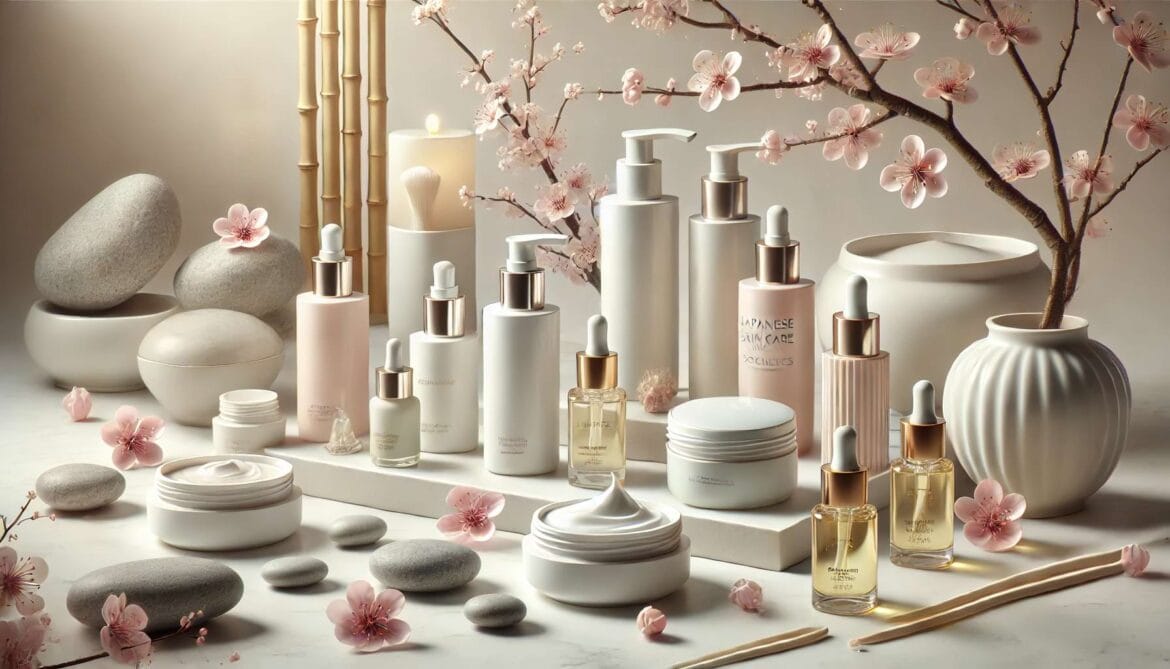Japanese skin care secrets have gained worldwide recognition for their ability to keep skin looking youthful, smooth, and radiant at any age.
The approach is simple yet powerful—focus on prevention, consistency, and using natural, high-quality ingredients.
1. Japan knows a lot more about skin care than we do
We’ve seen firsthand how adopting these techniques can transform your routine. Habits like applying sunscreen, cleansing gently, and layering lightweight hydration are central to achieving that soft, plump complexion often referred to as mochi hada—“rice cake skin.”
In this guide, we’ll share everything you need to know about Japanese skin care secrets. From techniques like double cleansing and layering hydration to selecting the right natural ingredients, we’ll walk you through how you can build a routine inspired by Japan’s best-kept beauty practices. Whether you’re new to skin care or looking to refine your existing routine, these insights will help you achieve healthier, radiant skin in the long run.
– Prevention and consistency matter most: Daily sunscreen, cleansing and hydration are essential for radiant skin.
– Natural ingredients make a difference: Rice bran, green tea, camellia oil, and seaweed are key in Japanese skin care.
– Simple routines bring lasting results: Start with a few high-quality products suited to your skin type and stick to a consistent routine for the best long-term outcome.
– Diet and rituals enhance skin health: A balanced diet, facial massage, and regular use of sheet masks can improve your skin from the inside.

2. Key Techniques in Japanese Skin Care
When it comes to Japanese skin care, technique is everything. It’s not just about the products you use—it’s about how you use them. Over time, we’ve seen that a few key techniques make a significant difference in maintaining smooth, healthy, and hydrated skin.
2.1 Double Cleansing: Removing Oil- and Water-Based Impurities
One of the most effective Japanese skin care secrets is double cleansing, a technique that thoroughly removes both oil-based and water-based impurities.
It is one of the most important steps in a Japanese skin care routine. Why? Because it ensures your skin is completely clean without stripping it of its natural moisture. We always recommend this two-step method to anyone looking to improve their routine.
- Step 1: Oil-Based Cleanser
Start with an oil-based cleanser. This step helps break down stubborn products like sunscreen, makeup, and excess sebum. Unlike harsh cleansers, oil cleansers dissolve impurities without leaving your skin dry. Many Japanese oil cleansers are infused with natural ingredients like rice bran oil or camellia oil, which nourish while they cleanse. - Step 2: Water-Based Cleanser
Follow up with a gentle water-based cleanser. This removes any remaining dirt, sweat, or oil residue. Together, these two steps ensure your skin is clean and prepped for hydration.
By adopting the double cleansing method, you’ll notice better absorption of hydrating products and, over time, a clearer, healthier complexion.
2.2 Layered Hydration: Keeping the Skin Plump and Moisturized
In Japanese skin care, hydration is more than just slapping on a moisturizer—it’s about layering lightweight hydrating products. This technique helps maintain moisture throughout the day without making your skin feel greasy.
Here’s how we do it:
- Start with a hydrating lotion or essence: These products are designed to deliver moisture deep into your skin. Unlike thick creams, they’re lightweight and quickly absorbed.
- Follow with a serum or emulsion: Serums provide targeted benefits, like brightening or anti-aging, while emulsions add an extra layer of hydration.
- Finish with a moisturizer: Lock everything in with a light moisturizer that seals the hydration in place.
By layering hydration, you can achieve that coveted “mochi hada” look—skin that’s soft, smooth, and bouncy, just like rice cake. This technique works for all skin types, including oily and sensitive skin.
2.3 Gentle Exfoliation: How to Smooth Your Skin Without Irritation
Gentle exfoliation is a key part of Japanese skin care secrets, helps keeping your skin smooth, but it’s easy to overdo it. We’ve learned that gentle exfoliation is the way to go—harsh scrubs can damage your skin barrier and cause irritation.
In Japanese skin care, natural exfoliants like rice bran and azuki beans are often used because they’re effective yet gentle. These ingredients not only remove dead skin cells but also provide additional nutrients to the skin. Another option we recommend is enzyme-based exfoliators, which work by breaking down dead skin cells without any abrasive action.
The key is to exfoliate once or twice a week, depending on your skin type. This keeps your skin texture smooth while preventing irritation or over-sensitivity.

3. Traditional Ingredients for Healthy Skin
What makes Japanese skin care stand out is its reliance on natural, time-tested ingredients. These aren’t just trendy—they’ve been used for centuries and are known for delivering real results. Below are some of the ingredients we trust and often recommend.
3.1 Rice Bran: Rich in Antioxidants for Softer Skin
We can’t talk about Japanese skin care secrets without mentioning rice bran. Known as komenuka in Japan, it’s packed with antioxidants, vitamins, and essential fatty acids that help soften and brighten the skin.
- Why we love it: Rice bran is rich in vitamin E and B-complex vitamins, which protect your skin from environmental damage while improving texture.
- How to use it: Look for cleansers, masks, or exfoliants containing rice bran. Regular use can help achieve a smoother, more radiant complexion.
3.2 Green Tea: Anti-Inflammatory and Anti-Aging Properties
Green tea, or matcha, is another powerhouse ingredient in Japanese skin care. It’s widely known for its anti-inflammatory and antioxidant properties.
- Why we love it: The catechins in green tea help reduce redness, calm irritation, and protect your skin from free radical damage. It’s also great for preventing early signs of aging.
- How to use it: Green tea-infused toners, masks, or serums can be a game-changer for anyone dealing with sensitive or acne-prone skin.
3.3 Camellia Oil: Deep Hydration Without Clogging Pores
Camellia oil, or tsubaki oil, has been a staple in Japanese beauty for centuries. It’s known for providing deep hydration without leaving a greasy feel.
- Why we love it: Camellia oil is lightweight, non-comedogenic, and packed with oleic acid, which helps restore moisture and improve skin elasticity.
- How to use it: Use it as a facial oil after applying your moisturizer, or mix a few drops into your cream for added nourishment.
3.4 Azuki Beans: Gentle Natural Exfoliation
Azuki beans have been used in Japan for centuries to gently exfoliate the skin. When ground, they form a fine powder that helps remove dead skin cells without irritation.
- Why we love it: Azuki beans contain saponins, which naturally cleanse the skin while improving circulation.
- How to use it: You can find azuki-based exfoliators or even DIY your own by grinding dried azuki beans into a fine powder.
3.5 Seaweed: Mineral-Rich Nourishment
Seaweed is another ingredient we highly recommend. It’s rich in minerals and antioxidants, making it perfect for hydrating and revitalizing tired skin.
- Why we love it: Seaweed helps maintain the skin’s moisture balance and strengthens its barrier function.
- How to use it: Look for seaweed-based masks, serums, or moisturizers to give your skin an extra boost of hydration and nutrients.
These traditional ingredients have stood the test of time for a reason—they work. Whether you’re looking to hydrate, soothe, or gently exfoliate, incorporating these into your routine can elevate your skin care game. Remember, it’s not about using everything at once. Start with one or two ingredients that fit your needs and build from there.

4. Sun Protection: A Non-Negotiable Step
When it comes to well known Japanese skin care secrets, sun protection is a must. We’ve seen how essential it is in maintaining youthful, healthy skin over time.
While many skin care routines focus on fixing existing damage, Japanese beauty places a strong emphasis on preventing damage before it starts—and nothing protects your skin better than daily sunscreen.
4.1 Why Daily Sunscreen Is Essential
UV rays are one of the biggest causes of premature aging, dark spots, and uneven skin tone. Even on cloudy days, UV rays can penetrate the skin and cause long-term damage. That’s why daily sunscreen use isn’t optional—it’s a core part of any effective skin care routine.
- Prevents premature aging: UV rays break down collagen, leading to wrinkles and loss of elasticity. Regular sunscreen use helps slow this process and keeps your skin looking younger for longer.
- Reduces pigmentation and dark spots: Sunscreen protects against hyperpigmentation caused by sun exposure. This is especially important if you’re trying to maintain an even skin tone.
- Protects against skin cancer: Prolonged UV exposure increases the risk of skin cancer. Using sunscreen daily reduces this risk significantly.
In Japan, sun protection goes beyond just sunscreen. You’ll often see people using hats, parasols, and UV-protective clothing to shield themselves from the sun. The combination of physical barriers and sunscreen provides maximum protection.
4.2 Popular Japanese Sunscreens and How to Choose One
Japanese sunscreens are known for their lightweight texture, high SPF, and broad-spectrum protection. Unlike some sunscreens that feel heavy or greasy, most Japanese formulas are designed to be comfortable enough for daily wear, even under makeup.
Here’s what we recommend when choosing a sunscreen:
- Look for broad-spectrum protection: This means it protects against both UVA (aging rays) and UVB (burning rays). Most Japanese sunscreens will clearly indicate “PA+++” or higher for UVA protection.
- Choose a lightweight, non-greasy formula: Many Japanese sunscreens are water-based or gel-based, making them ideal for layering with other skin care products. They absorb quickly and won’t leave a white cast.
- Check for additional benefits: Some sunscreens include added ingredients like hyaluronic acid for hydration or antioxidants for extra protection against free radicals.
Applying sunscreen every single day—rain or shine—is one of the simplest but most effective ways to protect your skin. Pairing a high-quality sunscreen with physical sun barriers like hats and UV-protective clothing will give you the best defense against premature aging and sun damage.

5. The Role of Diet in Skin Health
We’ve found that what you eat matters just as much as what you put on your skin. Japanese skin care isn’t limited to products—it also emphasizes nourishing your skin from within. A balanced diet, rich in nutrients, can support your skin’s health, making it more resilient and naturally radiant.
5.1 How a Balanced Diet Supports Glowing Skin
A well-balanced diet provides the essential nutrients your skin needs to repair itself, stay hydrated, and fight environmental stress. When your diet lacks key vitamins and minerals, it often shows up on your skin as dryness, dullness, or even breakouts.
- Antioxidants: Found in fruits and vegetables, antioxidants help neutralize free radicals that cause premature aging.
- Healthy fats: Omega-3 fatty acids, commonly found in fish, promote skin elasticity and hydration by supporting the skin’s natural barrier.
- Protein: Collagen, the protein responsible for keeping your skin firm, is built from amino acids. A diet rich in protein provides the building blocks for healthy, youthful skin.
By maintaining a balanced diet, you’re giving your skin the nutrients it needs to stay healthy and glowing.
5.2 Traditional Japanese Foods for Better Skin
Japanese cuisine is naturally rich in skin-friendly foods. Many traditional dishes include ingredients known for their antioxidant, anti-inflammatory, and hydrating properties.
Here are some key foods we recommend:
- Fish: Fatty fish like salmon and mackerel are high in omega-3 fatty acids, which help reduce inflammation and keep your skin soft and moisturized.
- Green tea: Rich in polyphenols, green tea helps reduce redness and protects against UV damage.
- Seaweed: Packed with vitamins, minerals, and antioxidants, seaweed helps maintain moisture balance and detoxifies the skin.
- Fermented foods: Miso, natto, and pickled vegetables are rich in probiotics, which support gut health. A healthy gut often leads to clearer, more radiant skin.
- Tofu and soy products: Soy contains isoflavones, which can help improve skin elasticity and reduce the appearance of fine lines.
Incorporating these foods into your diet can help improve your skin from the inside out.
5.3 The Importance of Hydration
Hydration is a cornerstone of healthy skin, and it’s something we always emphasize. Drinking enough water ensures that your skin stays plump, elastic, and less prone to fine lines.
We recommend aiming for 8-10 glasses of water a day and supplementing with water-rich foods like cucumbers, watermelon, and leafy greens. Additionally, green tea, a staple in Japan, offers both hydration and antioxidants, making it an excellent choice for your daily fluid intake.

6. Japanese Skin Care Practices Beyond Products
In Japanese skin care, the secret it’s not just about the products—it’s also about the techniques and rituals that enhance skin health.
These practices have been passed down through generations and are known for their ability to improve circulation, relax the mind, and boost overall well-being.
6.1 Facial Massage Techniques: Boosting Circulation
Facial massage is a key practice in Japan. It’s not just relaxing—it also helps improve circulation, reduce puffiness, and enhance the skin’s natural glow.
- Benefits: Regular facial massage stimulates blood flow, which brings more oxygen and nutrients to your skin cells. It can also help with lymphatic drainage, reducing puffiness and dark circles.
- How to do it: Use a facial oil or a light cream to prevent tugging on the skin. Gently massage in upward, circular motions, focusing on areas prone to tension, such as your jawline, cheeks, and forehead.
Incorporating facial massage into your routine a few times a week can lead to noticeable improvements in skin tone and texture.
6.2 Bathing Rituals: Relaxation and Skin Benefits
Bathing is more than just a way to cleanse the body in Japan—it’s a ritual that promotes both relaxation and skin health. Traditional Japanese baths, or onsen and ofuro, are known for their therapeutic benefits.
- Benefits: Warm baths help open up pores, making it easier for your skin to absorb moisture afterward. They also improve circulation and promote relaxation, which reduces stress—a known factor in skin issues.
- How to replicate it: Create a home spa experience by adding natural bath salts or green tea to your bath. After soaking, apply a body moisturizer to lock in hydration.
Taking time for a relaxing bath not only soothes the mind but also leaves your skin feeling softer and more hydrated.
6.3 Sheet Masks: Instant Hydration and Glow
Sheet masks are a popular Japanese beauty staple, and for good reason—they deliver instant hydration and a noticeable glow in just a few minutes.
- Why they work: Sheet masks are soaked in a concentrated essence that deeply hydrates the skin. The mask creates a barrier, allowing your skin to absorb the ingredients more effectively.
- How to use them: We recommend using a sheet mask 1-2 times a week, especially when your skin feels dry or tired. After removing the mask, gently pat the remaining essence into your skin—no rinsing needed.
Sheet masks are a quick, effective way to give your skin a boost, making them perfect for busy days or pre-event prep.
These techniques and rituals are simple yet highly effective. By incorporating them into your routine, you can enhance your skin care results and enjoy the relaxing benefits they bring. Whether it’s a quick facial massage or a soothing bath, these small practices can make a big difference in how your skin looks and feels.

7. Building Your Own Japanese-Inspired Routine
Creating your own Japanese-inspired skin care routine doesn’t have to be complicated. The key is to adapt these timeless techniques and ingredients in a way that works for your lifestyle. We always emphasize starting simple, choosing high-quality products, and, most importantly, staying consistent.
7.1 How to Adapt These Secrets to Your Lifestyle
You don’t need to overhaul your entire routine overnight. The beauty of Japanese skin care is that it’s flexible—you can gradually incorporate new steps and ingredients that suit your needs.
- Start with what’s essential: Focus on the basics first—cleansing, hydrating, and protecting your skin with sunscreen. These three steps alone can dramatically improve your skin’s health.
- Introduce techniques one at a time: Once you’ve mastered the basics, you can start adding techniques like double cleansing or layered hydration. The goal is to build a routine that feels sustainable, not overwhelming.
- Use natural ingredients where possible: Incorporating products with traditional Japanese ingredients like rice bran, green tea, or camellia oil can enhance your results. Look for products that match your skin type and needs.
Adapting these practices in a way that fits your lifestyle will help you stay consistent, which is ultimately what brings long-term results.
7.2 Choosing the Right Products for Your Skin Type
One of the most important steps in building your routine is selecting products that match your skin’s specific needs. We’ve worked with many different skin types, and here’s what we recommend:
- For dry skin: Look for products with hyaluronic acid, camellia oil, and ceramides to lock in moisture and strengthen your skin barrier.
- For oily or combination skin: Lightweight, water-based products like gel moisturizers and green tea-infused serums can hydrate without clogging pores. Double cleansing is especially helpful for controlling oil.
- For sensitive skin: Choose gentle, fragrance-free products with calming ingredients like rice bran and aloe vera. Avoid harsh exfoliants or alcohol-based toners.
- For aging skin: Products with antioxidants (like green tea or seaweed) and collagen-boosting ingredients are ideal for improving elasticity and reducing fine lines.
When choosing products, always patch-test new items to ensure they don’t irritate your skin. It’s all about finding what works for you and sticking with it.
7.3 Staying Consistent for Long-Term Results
Consistency is the cornerstone of any effective skin care routine. We often tell people that it’s not about how many products you use—it’s about how regularly you use them. A simple, consistent routine will always deliver better results than an elaborate one you can’t maintain.
- Stick to your routine: Whether it’s morning or night, try to follow the same steps daily. Over time, these small habits will add up to noticeable improvements in your skin.
- Track your progress: Pay attention to how your skin responds. If something works well, keep it. If a product causes irritation, replace it with something gentler.
- Be patient: Japanese skin care is all about long-term care. You won’t see dramatic changes overnight, but with consistent effort, your skin will improve steadily over time.
Building a routine that works for you takes time, but once you find the right balance, it becomes second nature. Stick with it, and you’ll see long-lasting results.

Conclusion
Japanese skin care is built on timeless principles—prevention, consistency, and the use of natural, high-quality ingredients. These aren’t quick fixes but rather thoughtful, long-term strategies that help maintain healthy, radiant skin.
By adopting these techniques and practices, you can create a routine that works for your unique needs. Start simple, choose products that match your skin type, and stay consistent. Over time, you’ll not only improve your skin’s appearance but also build habits that support your overall well-being.
If you’re just beginning, focus on the essentials: cleanse gently, hydrate well, and never skip sunscreen. From there, you can gradually add techniques like double cleansing, layered hydration, or gentle exfoliation to enhance your results.
Remember, skin care is a journey, not a sprint. Stay patient, stay consistent, and enjoy the process. Your skin will thank you for it.
FAQ
What makes Japanese skin care different from other routines?
Japanese skin care emphasizes prevention, gentle care, and consistent routines. The goal is to maintain healthy skin rather than treating problems after they appear. Key techniques include daily sun protection, double cleansing, and layering lightweight hydrating products.
How can I achieve ‘mochi hada’?
Mochi hada, or “rice cake skin,” is soft, smooth, and plump skin. To achieve this, focus on consistent hydration using multiple lightweight products, gentle exfoliation with natural ingredients like rice bran, and daily sunscreen use.
Why is double cleansing important in Japanese skin care?
Double cleansing removes both oil-based impurities (like makeup and sunscreen) and water-based impurities (like sweat and dirt). This two-step process ensures your skin is thoroughly cleansed and ready to absorb hydrating products.
What are the best natural ingredients in Japanese skin care?
Key ingredients include rice bran (for softness and antioxidants), green tea (for soothing and anti-aging benefits), and camellia oil (for deep moisture without clogging pores).
Can I use Japanese skin care techniques if I have sensitive skin?
Absolutely. Japanese skin care is known for being gentle and using natural ingredients. Just be sure to select products without harsh additives and always patch-test new items before full use.
Table of Contents
